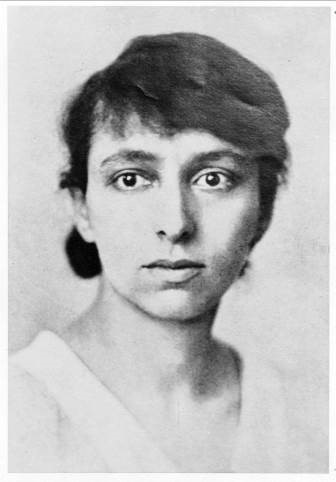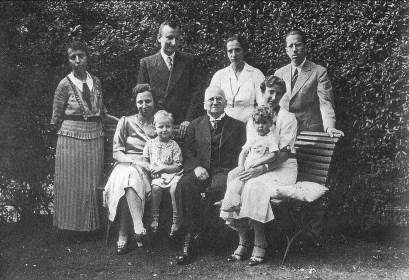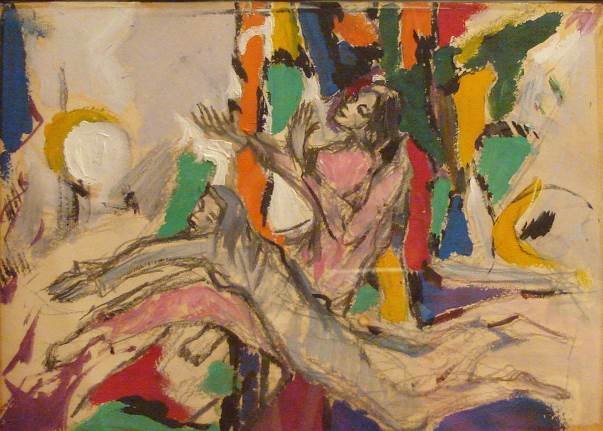Gertrud Kolmar in Falkensee -
Finkenkrug
Gertrud
Kolmar, 1928 (German literature archive, Marbach) The family Chodziesner in the garden of the Finkenkruger
house, 1937 (Nachlass Kolmar, German
literature archive Marbach). Front left to right: Gertrud Käthe Chodziesner Was deported to Auschwitz in 1943 and murdered Hilde Wenzel, geb. Chodziesner Emigrated to Switzerland in 1938, where she died in 1972 Sabine Wenzel Emigrated with her mother to Switzerland and now lives in
South America Ludwig Chodziesner Was deported to Theresienstadt in 1942 and died there in
1943 Thea Chodziesner geb. Galliner Emigrated to Chile in 1939 and died there in 1943 at the
age of 39 Wolfgang (Ben) Chodziesner Emigrated with his mother to Chile, later living in
Australia and died there in 2018 Rear from left to right: Peter Wenzel Emigrated to Brazil in 1953 and died there in 1961 Margot Chodziesner Emigrated to Australia in 1939, where she died in 1942 Georg Chodziesner Emigrated to England in 1939. He died in 1981 in Sidney

"... Oh, sometimes I would like to put on my coat,
put my hat on and walk away, far away. And I often think of it now, that once
snow falls, I can go to Finkenkrug and, in the moonlight, as I used to do, plod
around in the woods; but at the same time I already know that I will not carry
out this plan ... " Letter from Gertrud Kolmar to his sister Hilde Wenzel.
Berlin, December 13, 1939
Life and Work
The poet Gertrud Kolmar (1894-1943) lived in the house of
her parents in Falkensee-Finkenkrug from 1923 to 1939. The mansion on the then
Manteuffelstraße, today Feuerbachstraße, was surrounded by a large park-like
garden. In the beauty and seclusion of the place almost her entire lyrical work
was created. The flowers in the garden of the father and the beginning of the
house landscape with pines, sandy paths and animals found their way into their
world of poetry. Until his arrest by the National Socialists in February
1943, Gertrud Kolmar wrote short stories, plays and numerous poems. Her literary work could be saved with the help of the
family. The estate is in the German Literature Archive in Marbach and is
available for research purposes.
Remember Gertrud Kolmar
Thanks to an initiative of Dr. med. Maria Schaare and
Prof. Kurt Magritz, both from Falkensee-Finkenkrug, was unveiled on September
9, 1979 a memorial plaque for Gertrud Kolmar, which has meanwhile been listed
as a historical monument. In 2007, the artist Gunter Demnig laid two stumbling
blocks in the sidewalk in front of the former home. They are reminiscent of the
last freely chosen place of residence of the Jewish family Chodziesner. On 1 October 2011, a new breed of rose breeder Jan D.
Janßen from the Vierländerrosenhof in Hamburg in the presence of Gertrud
Kolmar's niece, Sabina Wenzel from Paraty (Brazil), was given the name
"Gertrud-Kolmar-Rose". While the permanent exhibition in the Museum
of the City of Falkensee shows traces of the life and work of Gertrud Kolmar,
the Rose Garden with the Gertrud Kolmar Rose in the back room of the museum
offers the opportunity to get to know the poet's attitude to life.
Hg. From Johanna Woltmann, Göttingen, Wallstein Verlag,
2014
Biography… 1894 Gertrud
Käthe Chodziesner was born on 10 December 1894 in Berlin-Mitte as the eldest
daughter of the lawyer Ludwig Codziesner and his wife Elise, nee Schönfließ. 1917 At the
instigation of the father of the band Gertrud Kolmar - poems published by Egon
Fleischl & Co. The pseudonym Kolmar derived them even from the German place
name (Kolmar) for the Polish town of Chodziesen. 1923 Family
moved to the colony of Neufinkenkrug, today's Feuerbachstraße. 1938 The
compulsory sale of the villa in December 1938. This resulted in the move of
Gertrud Kolmar and her father on 21 January 1939 in a so-called Jewish
apartment to Berlin-Schöneberg. 1943 During
the so-called factory action Gertrud Kolmar was arrested on February 27, 1943
with other Jewish forced laborers and taken to a transit camp. On
March 2, 1943, Gertrud Kolmar was deported to Auschwitz on the 32nd transport
to the East. Your date of death is unknown. Sources: Johanna Woltmann "Gertrud Kolmar - Life and
Work", Göttingen Wallstein Verlag, 1995 "Gertrud Kolmar - Letters" ed. By Johanna
Woltmann, Göttingen, Wallstein Verlag, 2014 Kurt Magritz: For Gertrud Kolmar, Colored sketch, 25 x 34
cm, early 1970s (private collection). Colored sketch
Colored sketch







